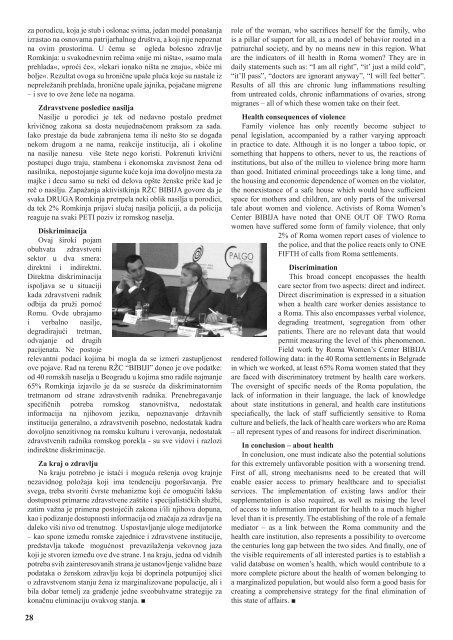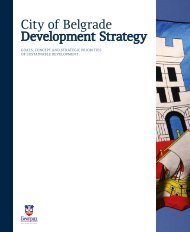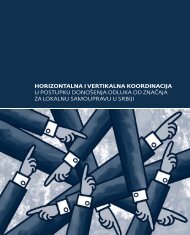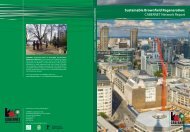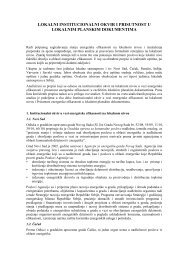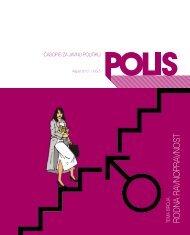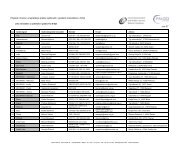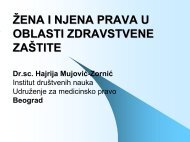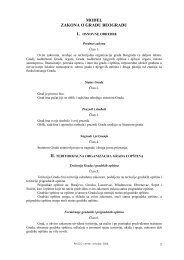Brošura u pdf. formatu - PALGO centar
Brošura u pdf. formatu - PALGO centar
Brošura u pdf. formatu - PALGO centar
Create successful ePaper yourself
Turn your PDF publications into a flip-book with our unique Google optimized e-Paper software.
za porodicu, koja je stub i oslonac svima, jedan model ponašanja<br />
izrastao na osnovama patrijarhalnog društva, a koji nije nepoznat<br />
na ovim prostorima. U čemu se ogleda bolesno zdravlje<br />
Romkinja: u svakodnevnim rečima »nije mi ništa«, »samo mala<br />
prehlada«, »proći će«, »lekari ionako ništa ne znaju«, »biće mi<br />
bolje«. Rezultat ovoga su hronične upale pluća koje su nastale iz<br />
nepreležanih prehlada, hronične upale jajnika, pojačane migrene<br />
– i sve to ove žene leče na nogama.<br />
Zdravstvene posledice nasilja<br />
Nasilje u porodici je tek od nedavno postalo predmet<br />
krivičnog zakona sa dosta neujednačenom praksom za sada.<br />
Iako prestaje da bude zabranjena tema ili nešto što se događa<br />
nekom drugom a ne nama, reakcije institucija, ali i okoline<br />
na nasilje nanesu više štete nego koristi. Pokrenuti krivični<br />
postupci dugo traju, stambena i ekonomska zavisnost žena od<br />
nasilnika, nepostojanje sigurne kuće koja ima dovoljno mesta za<br />
majke i decu samo su neki od delova opšte ženske priče kad je<br />
reč o nasilju. Zapažanja aktivistkinja RŽC BIBIJA govore da je<br />
svaka DRUGA Romkinja pretrpela neki oblik nasilja u porodici,<br />
da tek 2% Romkinja prijavi slučaj nasilja policiji, a da policija<br />
reaguje na svaki PETI poziv iz romskog naselja.<br />
Diskriminacija<br />
Ovaj široki pojam<br />
obuhvata zdravstveni<br />
sektor u dva smera:<br />
direktni i indirektni.<br />
Direktna diskriminacija<br />
ispoljava se u situaciji<br />
kada zdravstveni radnik<br />
odbija da pruži pomoć<br />
Romu. Ovde ubrajamo<br />
i verbalno nasilje,<br />
degradirajući tretman,<br />
odvajanje od drugih<br />
pacijenata. Ne postoje<br />
relevantni podaci kojima bi mogla da se izmeri zastupljenost<br />
ove pojave. Rad na terenu RŽC “BIBIJI” doneo je ove podatke:<br />
od 40 romskih naselja u Beogradu u kojima smo radile najmanje<br />
65% Romkinja izjavilo je da se susreće da diskriminatornim<br />
tretmanom od strane zdravstvenih radnika. Prenebregavanje<br />
specifičnih potreba romskog stanovništva, nedostatak<br />
informacija na njihovom jeziku, nepoznavanje državnih<br />
institucija generalno, a zdravstvenih posebno, nedostatak kadra<br />
dovoljno senzitivnog na romsku kulturu i verovanja, nedostatak<br />
zdravstvenih radnika romskog porekla - su sve vidovi i razlozi<br />
indirektne diskriminacije.<br />
Za kraj o zdravlju<br />
Na kraju potrebno je istaći i moguća rešenja ovog krajnje<br />
nezavidnog položaja koji ima tendenciju pogoršavanja. Pre<br />
svega, treba stvoriti čvrste mehanizme koji će omogućiti lakšu<br />
dostupnost primarne zdravstvene zaštite i specijalističkih službi,<br />
zatim važna je primena postojećih zakona i/ili njihova dopuna,<br />
kao i podizanje dostupnosti informacija od značaja za zdravlje na<br />
daleko viši nivo od trenutnog. Uspostavljanje uloge medijatorke<br />
– kao spone između romske zajednice i zdravstvene institucije,<br />
predstavlja takođe mogućnost prevazilaženja vekovnog jaza<br />
koji je stvoren između ove dve strane. I na kraju, jedna od vidnih<br />
potreba svih zainteresovanih strana je ustanovljenje validne baze<br />
podataka o ženskom zdravlju koja bi doprinela potpunijoj slici<br />
o zdravstvenom stanju žena iz marginalizovane populacije, ali i<br />
bila dobar temelj za građenje jedne sveobuhvatne strategije za<br />
konačnu eliminaciju ovakvog stanja. ■<br />
role of the woman, who sacrifices herself for the family, who<br />
is a pillar of support for all, as a model of behavior rooted in a<br />
patriarchal society, and by no means new in this region. What<br />
are the indicators of ill health in Roma women? They are in<br />
daily statements such as: “I am all right”, “it’ just a mild cold”,<br />
“it’ll pass”, “doctors are ignorant anyway”, “I will feel better”.<br />
Results of all this are chronic lung inflammations resulting<br />
from untreated colds, chronic inflammations of ovaries, strong<br />
migranes – all of which these women take on their feet.<br />
Health consequences of violence<br />
Family violence has only recently become subject to<br />
penal legislation, accompanied by a rather varying approach<br />
in practice to date. Although it is no longer a taboo topic, or<br />
something that happens to others, never to us, the reactions of<br />
institutions, but also of the milleu to violence bring more harm<br />
than good. Initiated criminal proceedings take a long time, and<br />
the housing and economic dependence of women on the violator,<br />
the nonexistance of a safe house which would have sufficient<br />
space for mothers and children, are only parts of the universal<br />
tale about women and violence. Activists of Roma Women’s<br />
Center BIBIJA have noted that ONE OUT OF TWO Roma<br />
women have suffered some form of family violence, that only<br />
2% of Roma women report cases of violence to<br />
the police, and that the police reacts only to ONE<br />
FIFTH of calls from Roma settlements.<br />
Discrimination<br />
This broad concept encopasses the health<br />
care sector from two aspects: direct and indirect.<br />
Direct discrimination is expressed in a situation<br />
when a health care worker denies assistance to<br />
a Roma. This also encompasses verbal violence,<br />
degrading treatment, segregation from other<br />
patients. There are no relevant data that would<br />
permit measuring the level of this phenomenon.<br />
Field work by Roma Women’s Center BIBIJA<br />
rendered following data: in the 40 Roma settlements in Belgrade<br />
in which we worked, at least 65% Roma women stated that they<br />
are faced with discriminatory tretment by health care workers.<br />
The oversight of specific needs of the Roma population, the<br />
lack of information in their language, the lack of knowledge<br />
about state institutions in general, and health care institutions<br />
speciafically, the lack of staff sufficiently sensitive to Roma<br />
culture and beliefs, the lack of health care workers who are Roma<br />
– all represent types of and reasons for indirect discrimination.<br />
In conclusion – about health<br />
In conclusion, one must indicate also the potential solutions<br />
for this extremely unfavorable position with a worsening trend.<br />
First of all, strong mechanisms need to be created that will<br />
enable easier access to primary healthcare and to specialist<br />
services. The implementation of existing laws and/or their<br />
supplementation is also required, as well as raising the level<br />
of access to information important for health to a much higher<br />
level than it is presently. The establishing of the role of a female<br />
mediator – as a link between the Roma community and the<br />
health care institution, also represents a possibility to overcome<br />
the centuries long gap between the two sides. And finally, one of<br />
the visible requirements of all interested parties is to establish a<br />
valid database on women’s health, which would contribute to a<br />
more complete picture about the health of women belonging to<br />
a marginalized population, but would also form a good basis for<br />
creating a comprehensive strategy for the final elimination of<br />
this state of affairs. ■<br />
28


